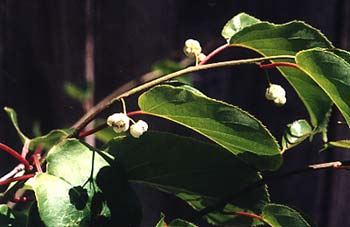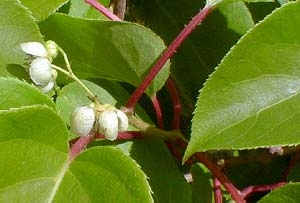Hardy Kiwi | |
 | |
The male is planted against the fence behind our Young's weeping birch, which likewise requires deep waterings. The female kiwi is very nearby on the opposite side of a gate. At the moment these vines are too young to produce fruit. The long term plan is to train the male kiwi up over the deck-porch, as it won't matter that we can't reach it to harvest fruit, which of course is the exclusive province of the female. The female we are training the full length of a fence, & as it grows larger in years to come it'll be trained over an arbor which will provide dappled shade for other plants.
Once established, kiwis will grow as much 25 feet per year. Size for all intent & purposes is limited only by the size & height of its support, which must be very sturdy indeed. For the female, three year old canes have to be removed each winter to insure a maximum fruit production on two year old canes.
Hardy kiwi does fruit very well on Puget Sound. Young plants usually don't start producing fruit until their third or fourth year. Thereafter new canes produce many fruits in the given cane's second year. Though old canes no longer produce fruit & should be removed, when young a main vine should be chosen to preserve as the central trunk. The beauty of this trunk is limited to the training ability of the grower. Given the correct form, it will be beautiful even in winter when all the leaves have fallen.
 When a kiwi is well-trunked, even the male can be "tapped" for sap, which is drinkable. Hardy Kiwi produces copious amounts of sap in the spring. This is why kiwis should never be pruned in spring; their great amount of sap means that pruning induces harmful bleeding. Light pruning can be done in July, but otherwise, winter is the correct time to cut back worn-out third-year canes.
When a kiwi is well-trunked, even the male can be "tapped" for sap, which is drinkable. Hardy Kiwi produces copious amounts of sap in the spring. This is why kiwis should never be pruned in spring; their great amount of sap means that pruning induces harmful bleeding. Light pruning can be done in July, but otherwise, winter is the correct time to cut back worn-out third-year canes.Long-lived, a big vine will produce for 60 years, & a single female plant can produce fifty to a hundred pounds of fruit. The fruits are beginning to be ripe late in summer & can be harvested throughout the autumn. If picked a little green they will finish ripening off the vine.
From a strictly ornamental point of view this is one of the most beautiful of large vines. The small white flowers, the large furry fruits, & big leaves are beautiful. In autumn the leaves turn a moderately bright golden yellow, as can be seen on the Hardy Kiwi Page of the Autumn Leaves Gallery. Even when the leaves have fallen in November, the main trunk of the kiwi can be lovely with its twists & bends, although that is rather dependant on how well it was trained as it aged.
In nature they do grow under large trees, but seek the upper reaches for best light. This means they tolerate shade well, but really want loads of sun, & offer the best appearance & fruit in a sunny location. Well-drained, loamy soil is best for it. The plant requires extravagant amounts of water during its growing season, & will not easily survive stress from drought. They also have a high nitrogen requirement so that occasional fertilizing will be needed.
One recommendation is to use citrus & avocado tree fertilizer in early March, sprinkled all around the vine & watered into the soil, then to boost the nitrogen again in early summer. It can be fertilized in autumn for slightly larger fruit, but is not essential. Enriching mulches are good in autumn strengthening the soil through the winter.